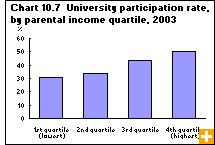Common menu bar links
Fewer low-income youth at university
Archived Content
Information identified as archived is provided for reference, research or recordkeeping purposes. It is not subject to the Government of Canada Web Standards and has not been altered or updated since it was archived. Please contact us to request a format other than those available.
Canada’s economically disadvantaged students are less likely to go to university than students from well-off families. In a 2007 study, just over half of the young people from families at the top of the income distribution attended university at age 19, compared with fewer than one-third of young people from families in the lowest 25%.
The study found only weak evidence that financial constraints were a direct barrier to attending university. Instead, it found that the gap is almost entirely associated with differences in academic performance and parental influences.
About 84% of the gap was related to the characteristics of youth from different economic backgrounds, such as their academic performance, parents’ level of education, parental expectations and high school attended. In contrast, only 12% of the gap in university attendance was related to the higher incidence of being “financially constrained” among lower-income youth.
Weaker academic performance among lower-income youth accounted for just over one-third of the gap. Specifically, young people from more disadvantaged backgrounds had a poorer performance on a standardized reading test and reported lower school marks at age 15.
An additional 30% of the gap was related to the lower levels of education of the parents of lower-income youth. About 12% was associated with the lower educational expectations that parents placed on lower-income youth.
The study concluded that the income divide in university participation is largely the result of factors that are present well before most youth begin to consider university.



